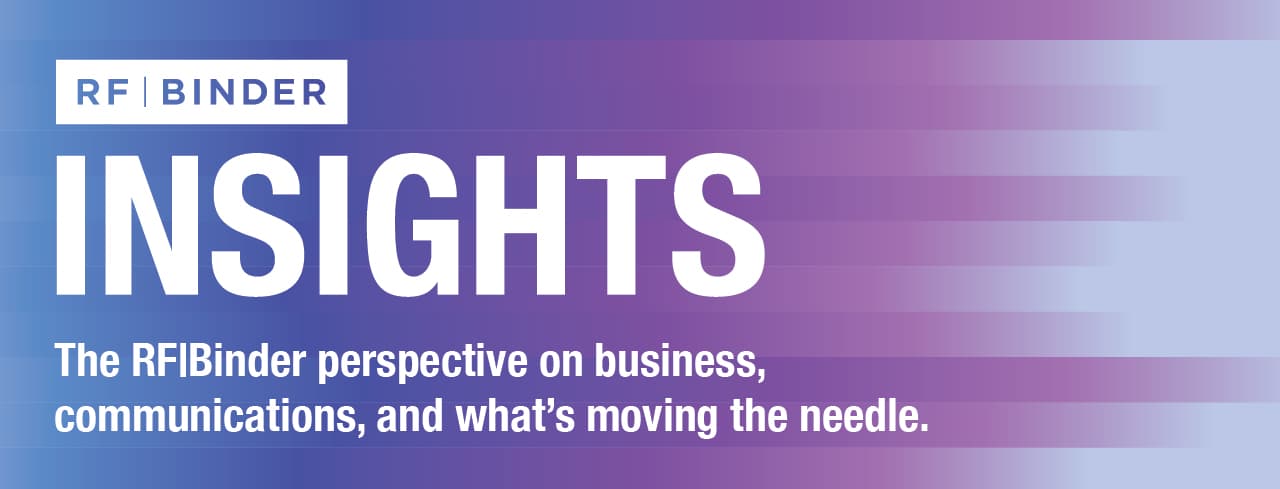At RF|Binder’s recent Hour to Empower, we heard from Stef Alicia McCalmon, award-winning entrepreneur, consultant and founder of social impact consultancy Stef Alicia Made (SAM). RF|Binder hosts Hour to Empower sessions regularly, featuring a diverse array of speakers and thought leaders. These sessions aim to ignite introspection, foster meaningful conversations and push new perspectives to lead to tangible outcomes for our clients.
Throughout her life, Stef Alicia McCalmon has been guided by the fundamental question of, “How do we elevate the voices of people in the margins and advocate for their representation?” It’s a question that deserves to be kept at the forefront of our minds as we navigate our work in the communications industry, as well as in our day-to-day lives. Through her social impact consultancy, Stef Alicia Made (SAM), Stef works with clients to address the systemic issues that impede social change and takes an intersectional approach to design thinking, advocacy and storytelling frameworks. She works across industries, including with universities, foundations, political organizers and nonprofits to inspire leaders to use their power and position in the push for a more just society.
Design Thinking to Build a Better Society
A theme that came up repeatedly in Stef’s work is that businesses wanted to “do something” to advance their social impact and inclusivity efforts but didn’t know what to do or how to make it happen. To address this challenge, Stef developed a curriculum based in design thinking, in which design thinking is the “how,” and social impact is the “what.”
Fundamentally, design thinking is about recognizing how the people who are most closely facing bias and discrimination are also the ones advocating the loudest for solutions. It helps those in positions of power to take a step back to listen to and learn from marginalized groups. Design thinking starts to get people familiar with this process and allows them to address one issue at a time. However, design thinking doesn’t stop there. The next step is to leverage this knowledge to advocate for solutions and build a better, more inclusive society. While we often hear about how people in positions of power are “listening and learning,” Stef emphasizes that the next step of “advocating and building” is crucial to drive tangible change.
Empathy, Imagination and Power’s Roles in Driving Change
Stef’s design thinking curriculum is built on the three key tenets of empathy, imagination, and power. According to Stef, intentionally elevating empathy in her work allows people to connect on a human-to-human level and fosters intentional interactions. Establishing these connections is crucial, as design thinking at its core is human-centered. While it’s easy for empathy to be overlooked in business settings, design thinking urges us to consider how our choices impact human beings on the other side of those decisions, both at work and in our personal lives.
The next pillar, imagination, is necessary to create change. Stef says that oftentimes, we get stuck in a mindset of accepting things the way they are, simply because that is how they’ve always been. Leaders must imagine change; according to Stef, if you believe something can be different, you have the power to make it different.
The last core value Stef teaches is power, at both the individual and collective levels. Her curriculum helps business leaders recognize and activate their individual power in their homes, neighborhoods and workplaces, and emphasizes the importance of collective power as well.
Prioritizing Brand Integrity and Internal Values Before Communicating Externally
Stef also discussed how she coaches clients on building brand integrity and communicating their core values. Her approach highly resonates with us in the communications industry. Stef stresses the importance of brands clearly establishing their values and sticking to them. It can be daunting for brands to be steadfast in their commitments, especially in such polarizing times. However, Stef reminds us that socio-political climates are constantly changing and encourages her clients to adopt the mindset of, “What can I build today that can still hold up 15 or 20 years from now?”
When brands make public-facing commitments to diversity and inclusion, Stef says it’s crucial that they have done the internal work to back up those commitments and avoid claims of performative activism. Oftentimes, brands want to jump straight to “taking a stance” and externally promoting their values. However, true brand integrity is built when companies take the time to reflect internally and understand why it is important to communicate these messages in the first place.
The clarity of communication Stef describes is top-of-mind at RF|Binder. Our work is guided by our Clarity Lens, which seeks to align clients’ communications strategy with their business strategy, and emphasizes that having a clear narrative that demonstrates who you are, what you do, why you exist and what you believe in matters. Ultimately, this approach drives growth and fosters brand integrity for our clients. While these principles guide our business, Stef’s story and work are good reminders that we should seek to live out these ideals in all aspects of our lives.

